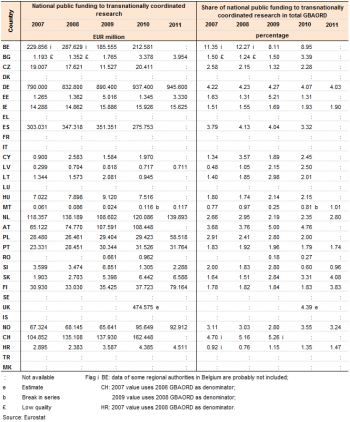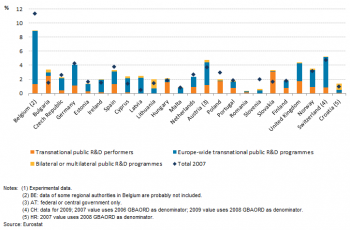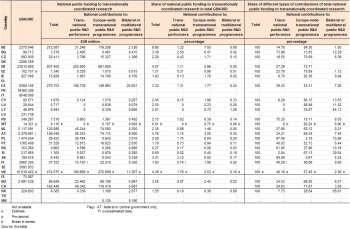Archive:R & D budget statistics - transnationally coordinated research
This Statistics Explained article is outdated and has been archived - for recent articles on this topic see here.
- Data from 2012, third round of experimental data collection.
This article presents the experimental results of the third round of data collection in the European Union (EU) and some EFTA and candidate countries on ‘national public funding to transnationally coordinated research'. Transnational cooperation in research is one of the core elements of the European Research Area (ERA) and EU public policies to promote it have grown in importance.
National public funding to transnationally coordinated research is measured as the 'government budget appropriations or outlays for research and development (GBAORD)' directed towards three categories of research and development (R & D) performers and programmes: transnational public R & D performers located in Europe, Europe-wide transnational public R & D programmes and bilateral or multilateral public R & D programmes established between Member State governments or with EFTA and candidate countries (see Data sources and availability).

Main statistical findings
(from the third round of experimental data collection 2012)
- On average, about 3.8 % of EU Member States’ R & D budget was directed to ‘transnationally coordinated research’ in 2010
In 2010, for the 21 EU Member States providing these data except Belgium, the share of the total R & D budget (GBAORD) that was used to fund ‘transnationally coordinated research’ ranges from 0.27 % in Romania to 4.76 % in Austria, with an EU aggregate of 3.79 % (based on the data for 21 Member States). Belgium stands out as an exceptional case, with 8.95 % of its R & D budget directed to transnationally coordinated research in 2010.
- The share of countries’ R & D budget directed to ‘transnationally coordinated research’ decreased slightly in 2010 compared to 2009
Between 2009 and 2010 the share of the R & D budget directed to ‘transnationally coordinated research’ increased most significantly in Bulgaria (from 1.50 % to 3.39 %) and Malta (from 0.25 % to 0.81 %). It decreased noticeably in Estonia (from 5.21 % to 1.31 %) and Slovenia (from 2.80 % to 0.60 %). At EU aggregate level (for the 21 Member States that provided the data on this indicator) it decreased slightly from 3.84 %, in 2009 to 3.79 % in 2010. In nominal terms national public funding to transnationally coordinated research increased in most of the countries except Estonia, Spain, Latvia, Lithuania, Hungary and Slovenia.
- Framework Programme instruments for coordinating national R & D programmes and other Europe-wide R & D programmes are a major driving force for transnationally coordinated research activities
In the majority of the countries that provided data, the largest share of the national contributions to transnationally coordinated research goes to the category ‘Europe-wide transnational public R & D programmes’. In Bulgaria, Hungary, Poland, Romania and Slovakia, the dominant category is ‘transnational public R & D performers’. In Lithuania and Croatia ‘bilateral or multilateral public R & D programmes’ registered the highest share.
The observations show the considerable importance of Europe-wide programmes in steering coordinated research in European countries. The use of Framework programme (FP) coordination instruments in particular (participation in ERA-NETs, European Technology Platforms, Joint Technology Initiatives) and coordination under the ESFRI Roadmap, are mentioned in all countries as major vehicles for implementing S & T and research coordination (Monitoring progress towards the ERA, European Commission, ERAWATCH Network, 2009).
Data sources and availability
The third round of data collection on ‘national public funding to transnationally coordinated research’ was conducted in 2012 by national statistical institutes under the guidance of Eurostat. As it is still an experimental data collection of this kind, the figures have to be viewed with the utmost caution and will be subject to revision in the coming years. Twenty four European countries, including 21 EU Member States, provided comprehensive data on this indicator.
The main source used by most of the countries for the compilation of these data is 'government budget appropriations or outlays for research and development (GBAORD)', in many cases supplemented with additional information from the national funding agencies/ministries. In some countries, R & D budget text analysis is combined with data collected through R & D surveys.
GBAORD covers not only government-financed R & D performed in government establishments, but also government-financed R & D in the other three national sectors (business enterprise, private non-profit, higher education) as well as abroad (including international organisations).
Transnational public R & D performers include:
- the European Organisation for Nuclear Research (CERN);
- the European Molecular Biology Laboratory (EMBL);
- the European Southern Observatory (ESO);
- the European Synchrotron Radiation Facility (ESRF);
- the Institut Laue-Langevin (ILL);
- the European Commission’s Joint Research Centre (JRC).
Europe-wide transnational public R & D programmes include: EUREKA, COST, ESA, ERA-NETs, ERA-NET+, EFDA, EUROCORES, Article 185 initiatives (Europe-developing countries clinical trials platform, Eurostars and Ambient assisted living for the elderly), Joint technology initiatives (public funding part: ENIAC, ARTEMIS). National contributions to FP funding which come from the overall national contributions to the total EU budget are not included in the data provided in Tables 1 and 2.
Bilateral or multilateral public R & D programmes established between Member State governments include: non-EC funded public R & D programmes jointly undertaken by the governments of at least two Member States, Candidate countries or EFTA countries, although other non-EU countries can also participate in them.
National public funding of transnationally coordinated research is measured as the 'government budget appropriations or outlays for research and development (GBAORD)' directed towards three categories of R & D performers and programmes:
- transnational public R & D performers located in Europe;
- Europe-wide transnational public R & D programmes;
- bilateral or multilateral public R & D programmes established between Member State governments (and with candidate countries and EFTA countries).
While the first category often involves cross-border flows of funds (the transnational R & D performer being located in one country is located abroad for all the other contributing countries), this is not the case for the second and third categories, which may or may not involve cross-border flows of funds. In most transnational R & D programmes, there is actually no cross-border flow of funds, as each country funds its own participants.
Transnationally coordinated research is not meant to be limited to European coordination only. Naturally, non-European countries participate in research activities performed by transnational public R & D performers located in Europe. Multilateral public R & D programmes between European countries can (and often do) include non-European countries.
Context
Transnationally coordinated public R & D activities are a key element and are growing in importance for the development of the European Research Area (ERA).
Over the past fifty years, Europe has been successful in establishing effective publicly-funded mechanisms for transnational cooperation in research. Various intergovernmental research organisations have been created, such as the European Organisation for Nuclear Research (CERN), the European Molecular Biology Laboratory (EMBL) and the European Space Agency (ESA). The European Commission’s Joint Research Centre has also emerged as an important R&D player. In the 1970s and 1980s, inter-governmental schemes such as COST and EUREKA were launched and the EU Framework programme for research was initiated.
In recent years new forms of transnational cooperation have started to emerge. Since 2005, the European Union has launched new instruments of coordination and collaboration known as ERA-NET and Article 185 initiatives. European countries will also be investing heavily in the ITER project, along with their international partners. In addition, European countries are now cooperating to fund and build the next wave of European (and international) research infrastructures, and 35 new pan-European infrastructures have already been identified by the intergovernmental body ESFRI.
In order to improve policy for the ERA, it is important to know what amount of public research effort in the ERA involves these (or other) forms of transnational cooperation, since the manner in which R & D funding is allocated has important implications for the achievement of the ERA objectives. In an effort to respond to this need, Eurostat carried out the third round of experimental data collection on ‘national public funding to transnationally coordinated research’ in 2012.
Further Eurostat information
Publications
- Science, technology and innovation in Europe - pocketbook - 2012 edition
- Europe in figures - Eurostat yearbook - 2011 edition
Database
The Eurostat database does not yet contain the data shown in this article.
Dedicated section
Other information
- Decision 1608/2003 of 22 July 2003 concerning the production and development of Community statistics on science and technology (legal text)
- Regulation 753/2004 of 22 April 2004 implementing Decision 1608/2003/EC as regards statistics on science and technology (legal text)
Methodology / Metadata
- Government budget appropriations or outlays on R&D (ESMS metadata file - gba_esms)
External links
- ERAWATCH Reports, see 'Monitoring progress towards the ERA', 01/10/2009
- European Commission - NETWATCH: Platform on transnational R&D programme collaboration

